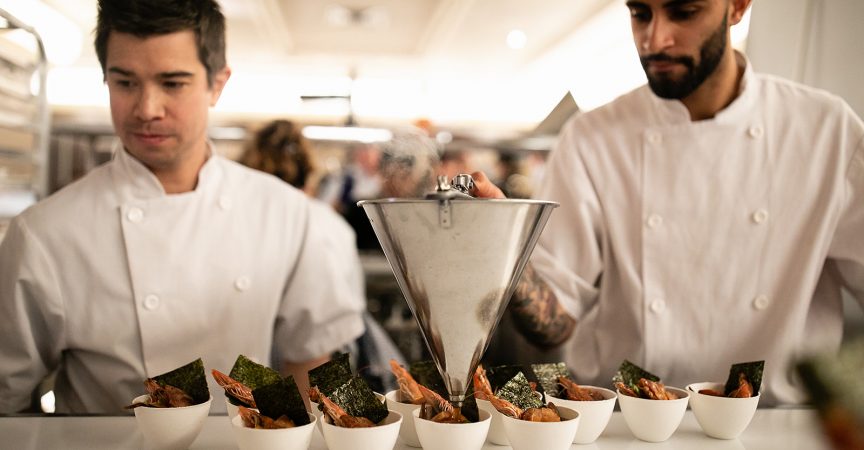7 Key Takeaways from Terroir Symposium 2019
Photo Credit: Ash Nayler Photography
This past May, the Terroir Symposium took place at The Carlu in Toronto with the theme of ‘Choices’. In the opening remarks, Chef Amanda Cohen of Dirt Candy NYC regaled a story about how given too much choice at her restaurants, patrons would often make the wrong decision.
Customers would choose to order a few small plates and complain that there wasn’t enough food, or they would opt for a couple of large entrees and voice their concern that there was too much food.
Frustrated, Chef Cohen decided to do away with the choices and established a tasting menu. By taking away the plethora of choices offered, she presented consumers with the best possible experience.
I feel confident saying that, for many of us, this story mimicks the current state of modern life, not just the foodservice and hospitality industry.
In our professional and personal lives, we’re confronted with so many options, it can be overwhelming. I mean, just take a trip to the grocery store and walk down any aisle!
As stakeholders in the restaurant business, we’re presented with choices on everything from what straws to use, to what oven to install. And unfortunately, there isn’t anyone who will magically provide us with the correct choice to make. There is no tasting menu for life. What we need to do, is educate ourselves.
We need resources and tools to gain insights in order to go forward with the most sustainable option- whether it’s for a more sustainable community, future, environment, or business.
With that in mind, we’ve highlighted some of the learned lessons from Terroir 2019. These are the takeaways we’re marking as ‘need-to-know’ as we move to make more choices this year.
The cannabis industry has sprouted and is growing like a weed
With the legalization of cannabis, the foodservice is abuzz with mentions of edibles, but we’ve also started to scratch the surface of cannabis tourism. Enter in the small town of Smith Falls. 9,000 people call Smith Falls home; it was once known for being the locale of the Hershey’s Factory, which closed its doors in 2008.
In 2014, Canopy Growth, one of Canada’s largest cannabis companies, purchased the site to use as headquarters for their company Tweed Inc.and in the process, created jobs for locals and revitalizing the town. Smith Falls was even visited by Snoop Dogg himself! Snoop has partnered with Tweed to distribute his brand of cannabis products.
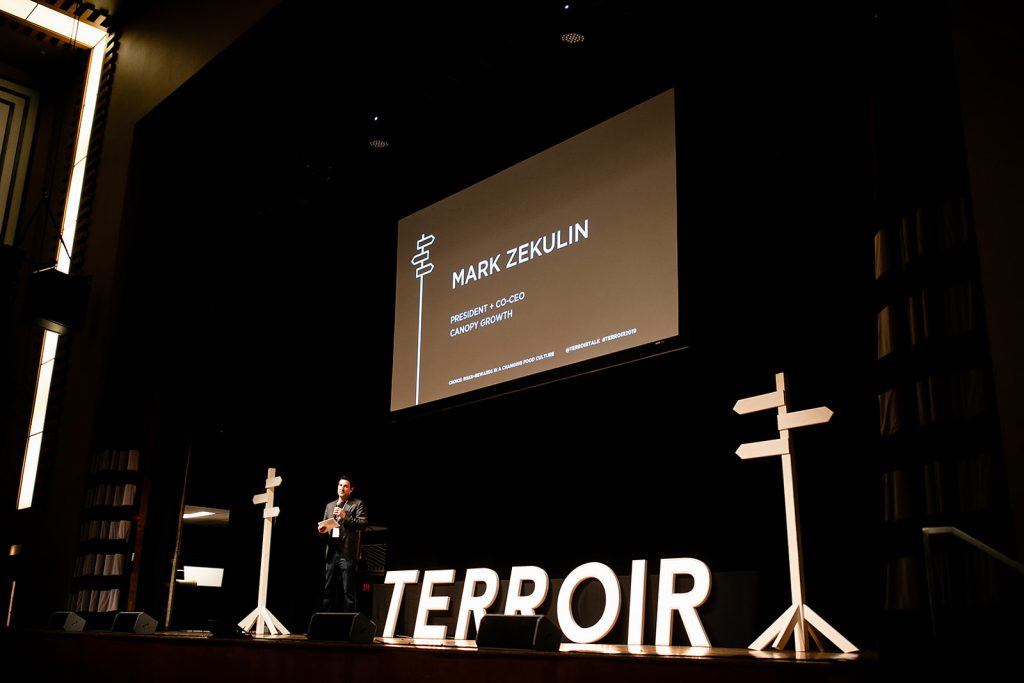
An hour from Ottawa, Smith Falls has been transformed into a tourist attraction in its own right, due in large part to Tweed and Canopy Growth. Similar to a brewery tour, Tweed offers visitor tours that take guests to peek inside grow rooms and learn about cannabis.
Canopy Growth President and CEO Mark Zekulin spoke to the Terroir audience about the upcoming possibilities and plans for the Tweed Visitor Centre, including a cannabis-infused chocolate shop, combining cannabis and tourist-friendly pastimes like golfing. While cannabis may not pair well with all activities (axe-throwing for instance, may be a no-go), blending cannabis with these trendy pursuits can make for a lucrative tourist opportunity, that simultaneously restores a community.
We should all be eating more seaweed and tempe
After hearing Taylor Widrig speak about seaweed, I’m wondering why we aren’t as obsessed with it as we are avocados. Widrig owns Mermaid Fare, out of Nova Scotia. Since 2013, Mermaid Fare has been providing “sustainably managed’ sea vegetables (as Widrig likes to call them), produced and packaged in Nova Scotia.
These sea veggies are a locally-produced, plant-based protein source that does not require land, feed, or fertilizer to grow. According to Mermaid Fare, sea veg are highly nutritious, containing trace minerals, vitamin C, omegas, calcium, and a range of B vitamins.
Not only do sea veggies provide us with much-needed nutrients, but as Mermaid Fare’s website states, “research shows wild and cultivated seaweeds positive effects in C02 sequestration and reducing ocean acidification – making sea vegetables both a suitable food source and commercial ingredient for the future”.
Joining the ranks of foods that that deserve more recognition, is tempe. Tempe isn’t unknown necessarily, it’s a favourite of vegetarians and vegans who are looking for a hearty protein source, however, it definitely deserves its moment in the spotlight.
Wida Winaro works for the Indonesian Tempe Movement, a non-profit organization that “aims to increase national and international awareness of tempe as: a healthy food, sustainable protein source, and affordable protein source”.
To that end, Winaro points to the fact that tempe is low in fat, contains no cholesterol, and is a good source of fibre, calcium, iron, zinc, vitamin B12, and paraprobiotics. Not to mention, tempe has a similar amount of protein compared to beef, but requires “10x less energy use”, “is 20 times more land efficient” and produces significantly less carbon dioxide emissions; adding to all this is the fact that tempe is “only up to 4% of the price of beef [in Indonesia]) (1).
The key takeaway is this: there are alternative protein sources, readily available to us, some from our own backyard that we need to take advantage of.
Trash can be treasure
One of the highlights from this year’s Terroir event was the ‘Trashed at Terroir’ lunch. The lunch featured 10 chefs from across North America. Each chef was tasked with ‘rescuing’ an ingredient, otherwise bound for the trash. The variety of resurrected ingredients, brought back to life in innovative dishes was eye-opening.
Meghan Robbins, of Superpoint in Toronto, Ontario used day-old bread to create rye ice cream with sourdough amaretti cookies and toasted sweet bread crumbs. Kiki Aranita, of Poi Dog in Philadelphia used day old bread and tuna bloodlines to create ahi tuna bloodline latkes.

Kiki Aranita, of Poi Dog in Philadelphia
Photo Credit: Ash Nayler Photography
Jason Sawision of Stofa Restaurant in Ottawa, Ontario took lobster shells to fabricate a chicken bacon ramen. George Lenser of The Skeena Bar in Terrace, British Columbia saved brown avocados and wilted cucumbers in a seal tartar dish, as an homage to his aboriginal heritage. Ryan Crawford of Backhouse in Niagara-on-the-Lake, Ontario took home the people’s choice prize for his wood-fired mushrooms on toast with rescued egg whites, garlic ends, and peach tree trimmings.
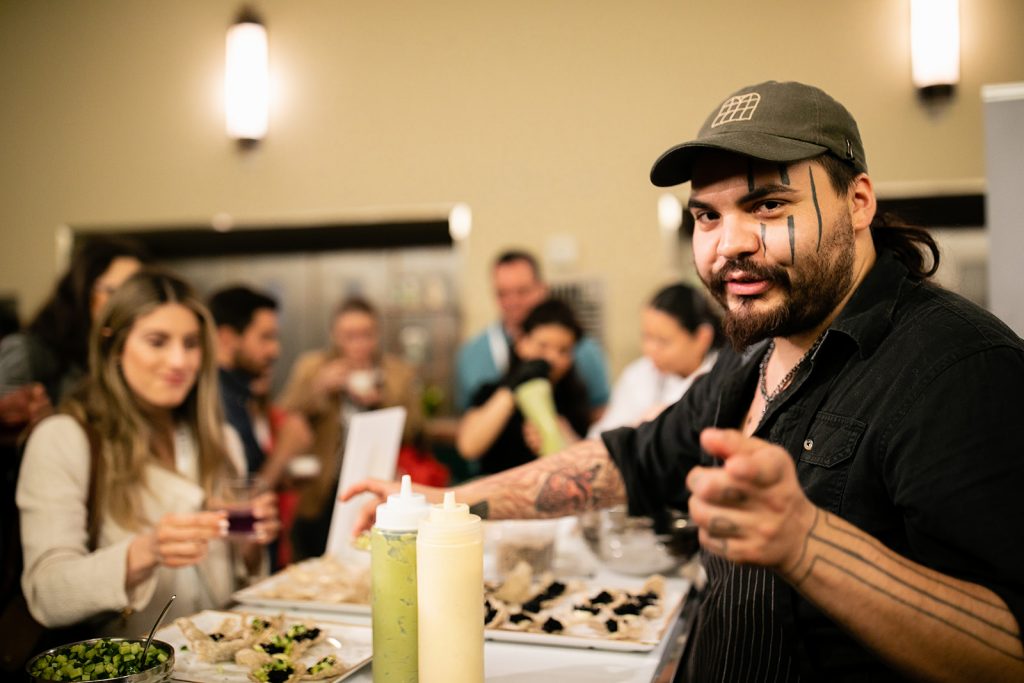
Photo Credit: Ash Nayler Photography
Understanding that these delicious meals were created with what would have been trash was a clear indication that we’re wasting food unnecessarily. Ingredients that we might think are only good for the trash, don’t need to be with a little experimentation and modification. When it comes to food waste, it’s about making the most of what we have, but also recycling and renewing the leftovers.
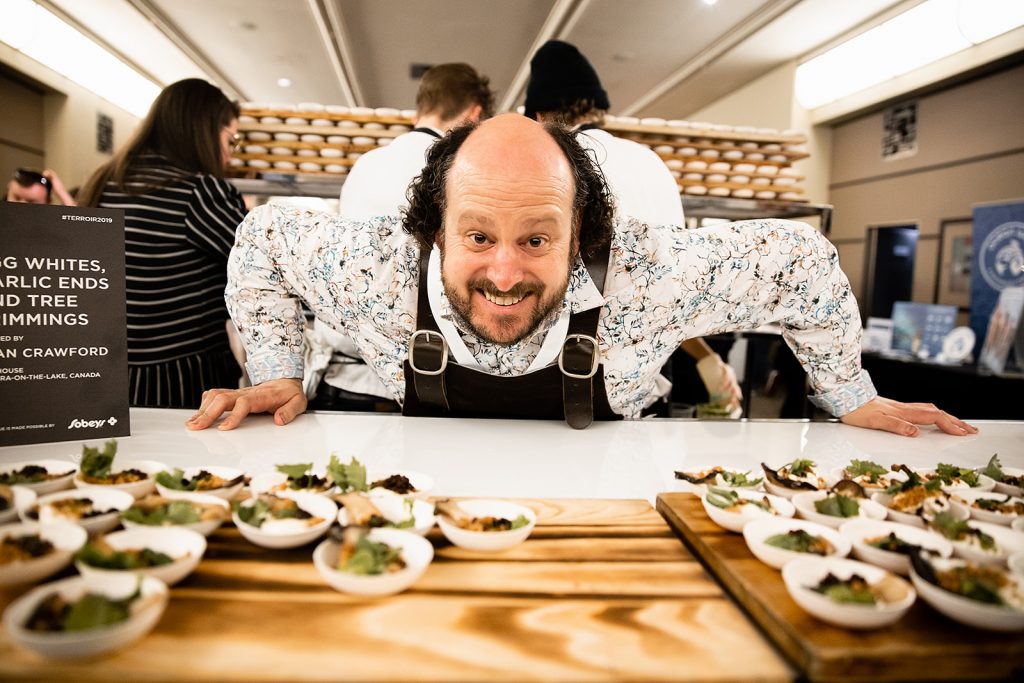
Photo Credit: Ash Nayler Photography
Punch up, not down when it comes to promoting veganism
According to 2018 research by Dalhousie University, vegetarians and vegans represent nearly 10 per cent of Canada’s population. There are 2.3 million vegetarians in Canada, which is up from 900,000 15 years ago (2). Considering the immense popularity of plant-based protein brands like Beyond Meat, and with changes to Canada’s food guide, I would venture to say that the number of vegans or vegetarians has risen since the beginning of 2019.
As more Canadians choose to make changes to their diet, it’s inevitable that plant-based meals become more and more trendy. Cauliflower-based pizza crusts are available in your local supermarket freezer section! However, plant-based diets can be intimidating to say the least. There’s the perceived cost associated with plant-based meals, and the effort or time associated with making these meals. I for one, can safely say that I will never soak beans overnight.
These large hurdles to going vegan can prevent many individuals from taking the plunge, or even considering it. But as some move towards this seemingly ‘healthier’ lifestyle, there can be shame associated with those that choose to continue to eat meat. Articles like ‘I went vegan for a week and it was so easy!’ add to the shaming. If everyone else can do it- why can’t you?
This is where the concept of punching up, not punching down comes in. Journalist Denise Balikssoon spoke about the idea of targeting ‘Big Food’ – large food companies and brands when it comes to promoting veganism, instead of individuals or communities.
Balikssoon specifically pointed to seal hunting in the Territories. Seal is a controversial meat, and eating it has negative connotations. However, for communities living in the Territories, seal meat is an essential portion of their diet.
The permafrost doesn’t allow for fresh veggies or fruits to grow but seal meat contains many of the vitamins and nutrients that individuals would otherwise get from fresh produce. And during the winter season, when sunlight is scarce, seal meat provides vitamin D.
Punching down would be to make an example of these communities, to put them on blast for eating seal meal. Why not make an example of ‘Big Food’ that don’t offer reasonable prices for produce, or a variety and abundance of fresh produce?
Putting more thought into who we are pressuring to make changes, is integral to effort of making a change. Balikssoon also used the commonplace example of protesting a mom n’ pop butcher shop or restaurant that serves game meats, she posited that hindering the business of a small operation is an example of punching down. Instead, punch up and pressure large corporations to treat animals better, or to offer more affordable vegetarian options.
What makes your terroir unique is what draws business
During Terroir, we had the opportunity to visit South Pond Farms in the Kawarthas in southern Ontario with the Culinary Tourism Alliance for a full day of feasting on local, Ontario ingredients. The event celebrated the produce and products grown or developed in Ontario. Many of us don’t realize the variety of produce and products available from our own backyard, and we don’t often showcase these items as something uniquely Ontarian.
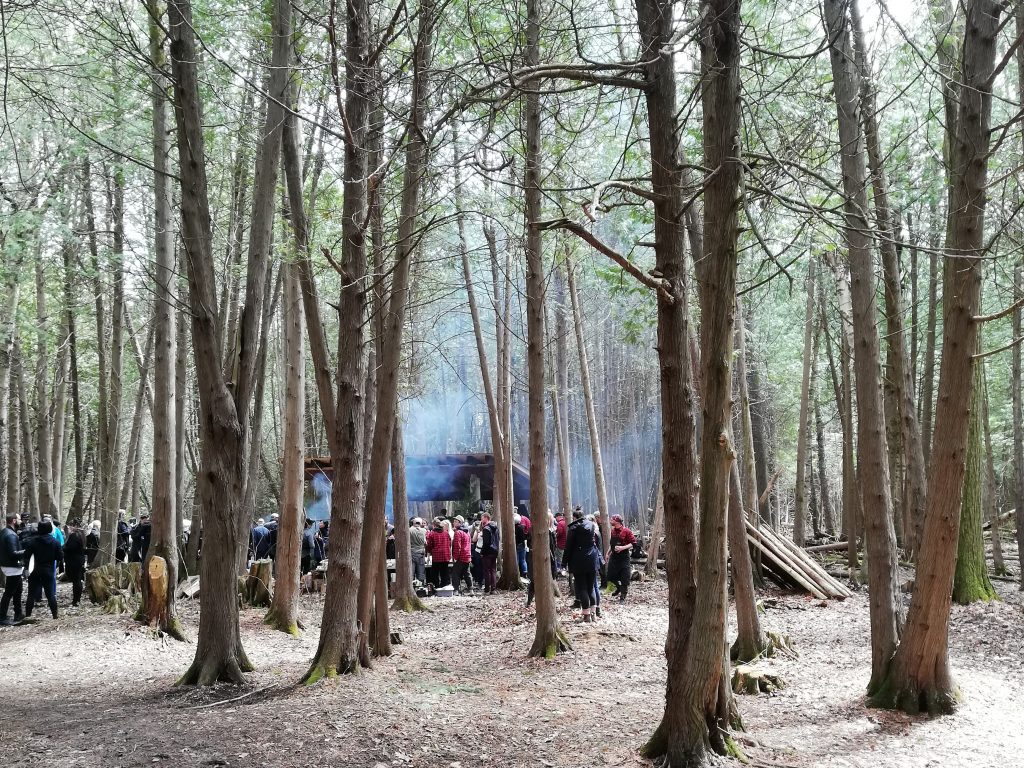
However, when we consider that eating in restaurants is the number one leisure activity for US travelers in other countries, and that foodservice represents 23% of total tourist spending (3), the importance of culinary tourism shouldn’t be understated.
According to the Culinary Tourism Alliance, tourists want an authentic experience when visiting. In essence, they want to ‘taste the place’. Canada, being so vast, is lucky in that each region has created their own taste of place and this can be leveraged for a unique travel adventure. Consumers want to know that what they’re seeing, feeling, and tasting is local.
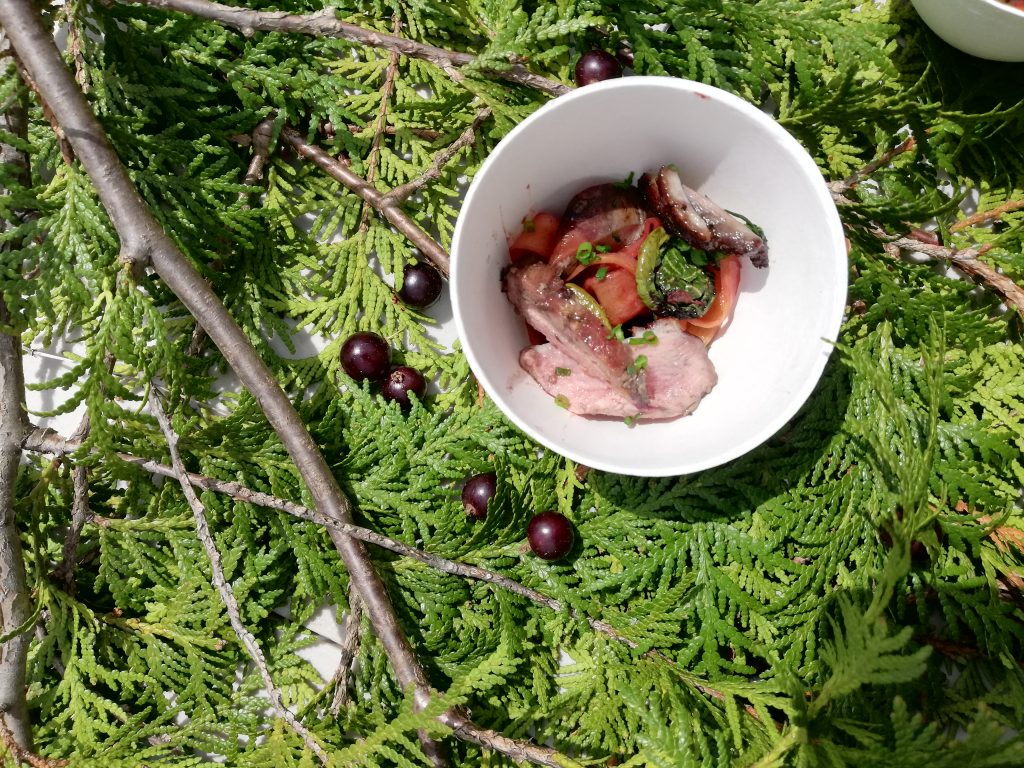
Bringing these ingredients that are specific to the area is how you differentiate and set yourself apart as a business (be sure to read more about building a culinary tourism strategy here).
The Culinary Tourism Alliance recommends that foodservice and hospitality establishments develop partnerships with other local businesses in the community as well as with destination marketing organizations. Keeping in mind that culinary tourism can take many forms, think about the Butter Tart Trail or Apple Pie Trail as examples of how partnering up with other businesses can help promote culinary tourism.
We have the choice to support the community
Supporting the community goes hand-in-hand with sustainability, and your business’ success. Part of a establishing a sustainable foodservice business is understanding the impact you have on the community. There’s more to a sustainable business practices than offering reusable straws.
Past RC award winner Mark Brand spoke at Terroir about his business, Save on Meats in Vancouver, Canada. An integral part of the Save on Meats business is their charity work. Save on Meats allows customers to purchase tokens for free sandwiches, that they can then distribute to the local homeless population. Having overcome addiction himself, Brand also makes a point to work with and hire Vancourites working to become sober, or homeless Vancouverites.
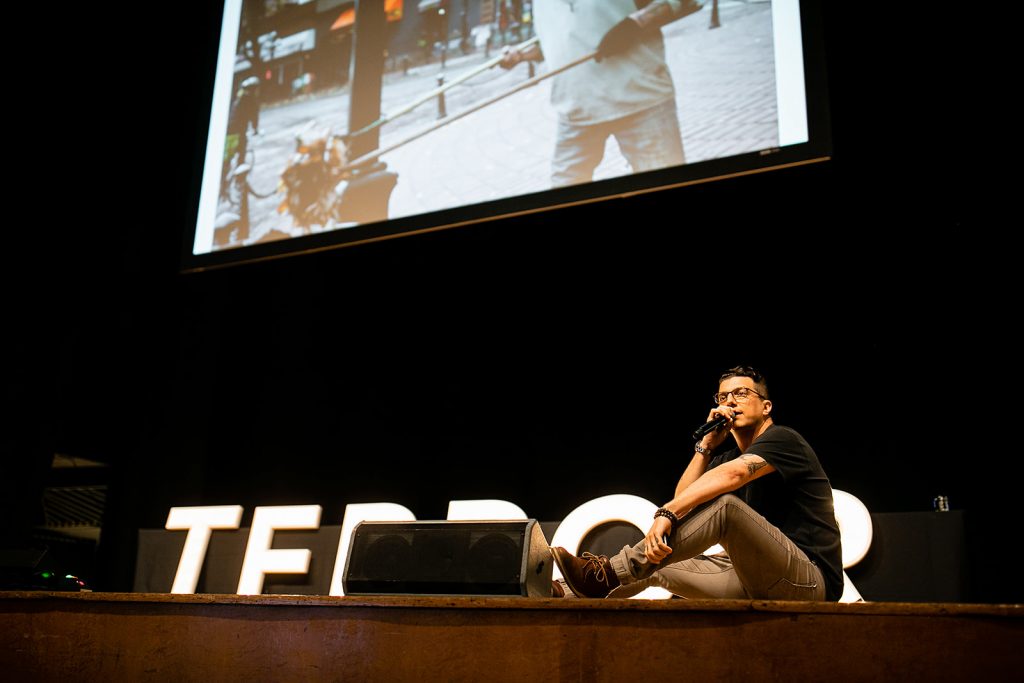
Photo Credit: Ash Nayler Photography
Mark has made the choice to impact his community in a different way. He works to make the city more sustainable, in turn ensuring his own business retains a sustainable status. It’s a win-win situation, for Brand who can feed those who need it and empower community members, and for Brand’s business which continues to flourish.
We also heard from Paul Newnham, Executive Director of the SDG Chefs Manifesto. SDG2 Advocacy Hub brings “together NGOs, agricultural networks, nutritionists, campaigners, civil society, the private sector and UN agencies to coordinate advocacy efforts”. The goal is to end hunger, achieve food security, improve nutrition, and promote sustainable agriculture by 2030.
The Chefs Manifesto is one of the actions led by SDG2. This community of chefs champions food biodiversity in their kitchens and recipes for a more diverse, sustainable and delicious future. Protecting biodiversity is vital to feeding a growing population. Paul Newnham’s Chefs Manifesto is an example of how, on a more global scale, chefs can lead by example for a more sustainable future.
We need to preserve, as much as we need to innovate
Culture and food are intertwined, culture influences food and food influences culture. What we eat can determine how it is cooked, our technology and our habits. At the same time, belief systems and traditions can determine what we eat.
Preserving culture through food means we are holding onto traditions, passing them on, and sharing them. Liz Alpern and Jeffrey Yoskowitz are co-founders of The Gefilteria, a ‘culinary laboratory’ that is reimagining traditional Ashkenazi cuisine. As Alpern and Yoskowitz saw New York’s Jewish delis closing, and as the previous generations began to be too old to cook, they noticed a need to preserve their heritage.
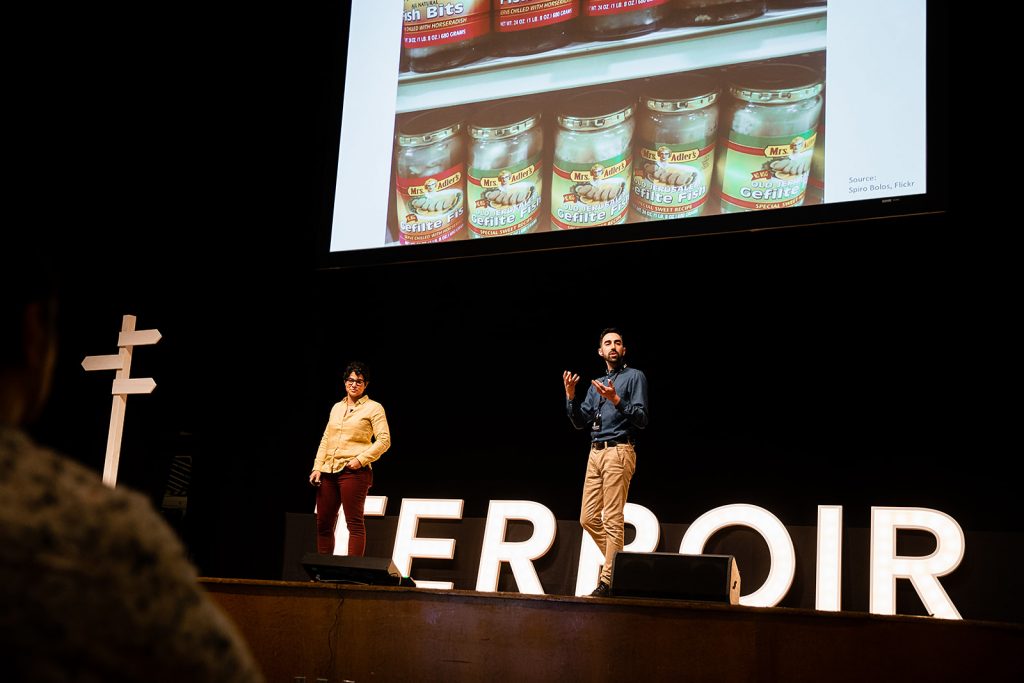
Liz Alpern and Jeffrey Yoskowitz at Terroir
Photo Credit: Ash Nayler Photography
They began with a quintessential dish – gefilte fish. They decided to produce a gourmet version, sustainably-sourced, of high quality for a new audience. As The Gefilteria puts it, “We need not accept the extinction of this tradition, or of the robust, colorful, fresh flavours of Ashkenazi cuisine. We know that gefilte – like borscht and kvass and so many old world foods – is excellent when done right. It comes down to the basics of quality, freshness, care and creativity”.
But beyond just producing gefilte fish, The Gefilteria brought Jewish cooking to the people of New York with pop-ups, private dinners, cooking lessons, collaborations, and now – a cookbook. They’ve been able to not only preserve culture, but by presenting these traditions in new contexts, to a new audience, they’ve innovated as well.
Chef Selassie Atadika has built a career that focuses on culture, community, and cuisine at her restaurant Midunu, in Ghana. Chef Atadika works to preserve Ghanan heritage while incorporating sustainable practices for an innovative approach to African dining.

Photo Credit: Ash Nayler Photography
With a plant-forward menu that utilizes local components like legumes, seeds, grains, Chef Atadika produces a menu of bold flavour. The restaurant is heavily influenced by a West African flavour profile, bringing new value to ‘often overlooked ingredients from the region’. The food is a ‘celebration of [its] origins’.
The restaurant philosophy is reflected in their nomadic dining experiences. As the meal tells the story of how the food came to be on the plate, the communal meals are an opportunity for fellow foodies to interact and widen their horizons. Chef Atadika has managed to source foraged and wild ingredients from West Africa for a familiar taste, but produced in a conscious way that echos current issues around foodservice.
It’s not always evident what the right path to take is. Being faced with so many choices every day is sometimes paralyzing; whether it’s what milk to use in our coffee, or whether or not to shop locally, figuring out the most sustainable choice to make isn’t easy. Hearing the stories and experiences of Terroir 2019, and learning how others in the foodservice industry have navigated their way through the minefield of choices allows us to take from their success and mistakes and apply them to our own paths. While we may not have a tasting menu for life, we do have the collected experiences of the foodservice and hospitality community.



